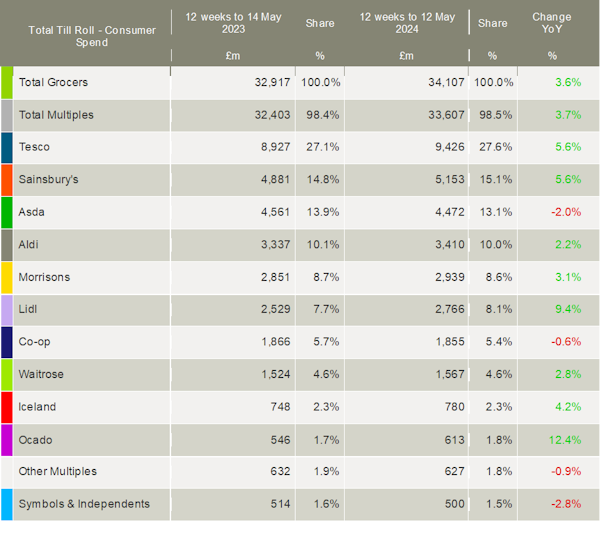Latest figures from Kantar Worldpanel show that take-home grocery sales in the UK rose by 2.9% over the four weeks to 12 May, while grocery price inflation fell for the fifteenth month in a row to 2.4% – the lowest level since October 2021.
“Grocery price inflation is gradually returning to what we would consider more normal levels,” said Fraser McKevitt, head of retail and consumer insight at Kantar. “It’s now sitting only 0.8 percentage points higher than the 10-year average of 1.6% between 2012 and 2021, which is just before prices began to climb.
“Typically, an inflation rate of around 3% is when we start to see marked changes in consumers’ behaviour, with shoppers trading down to cheaper items when the rate goes above this line and vice versa when the rate drops. However, after nearly two and a half years of rapidly rising prices, it could take a bit longer for shoppers to unwind the habits they have learnt to help them manage the cost of living crisis.”
Kantar noted that demand for own-label lines was proving resilient, and they are still growing faster than brands, making up 52% of total spending. This was driven by premium own-label ranges, which saw sales grow by 9.9% year-on-year.
Ocado was again the fastest-growing grocer over the 12 weeks to 12 May, with sales up by 12.4% – well ahead of the total online market, which saw sales increase by 5.4%. The online retailer accounts for 1.8% of the grocery market, although this figure rises to 3% in London. Outside of the capital, Ocado saw its strongest growth in the south and east of England, where one in twenty households shopped at the retailer during the period.
Meanwhile, Lidl reached a record-high market share of 8.1% after seeing sales rise 9.4%, fuelled in part by its bakery counters and recently revamped loyalty scheme. Freshly baked bread, cake or pastry made it into a quarter of baskets at the discounter over the 12 weeks, and coupons through the Lidl Plus app helped push volume sales of in-store bakery items up by more than 40%.
Tesco now controls 27.6% of the market – an increase of 0.5 percentage points since last year, marking its largest annual share gain since January 2022. Its 5.6% growth in sales was matched by Sainsbury’s, whose market share edged up 0.3 percentage points to 15.1%.
Despite rolling out a series of initiatives aimed at boosting performance, Asda continued to struggle, with its sales down 2.0% and market share slipping to 13.1%. Aldi also lagged behind its rivals, growing just 2.2% after facing tough comparatives with its strong performance last year.
Morrisons continued its steady recovery under new management, with sales up 3.1% and only a slight fall in market share.
Kantar noted that with the UEFA Euro 2024 football tournament and the Olympic Games on the horizon, the summer months could deliver a welcome boost for the sector.

NAM Implications:
- Whilst food inflation appears to have crossed down to the ‘affects buying behaviour‘ line…
- …brands should be concerned that consumers, having tried own label…
- …and found the compromise to be less than anticipated…
- …may be expensive to win back to brand equivalents.
- Meanwhile, Asda, despite refinancing debts, may find it difficult to ‘price-fight’ for market share.
- Tesco’s share growth to 27.6% has to be of concern to rivals…
- …especially given its recent ramping up of Retail Media plans.
- Despite Aldi’s slippage to 10% share, the combined discounter share of 18.1% must still be of concern to the mults.
- Meanwhile, Morrisons’ new momentum adds pressure to rivals…



